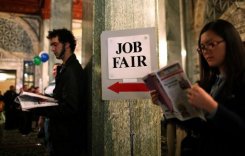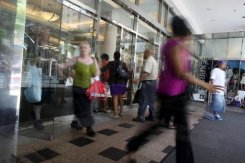 |
| Ben Bernanke has said that unemployment, and the lack of consumer confidence, is the economy’s biggest problem © AFP/Getty Images/File Justin Sullivan |
WASHINGTON (AFP) – The threat of inflation is expected to temper any decisions on new pro-growth measures when Federal Reserve policy-makers meet Tuesday on the US economy’s poor health.
With growth stagnating and unemployment stubbornly above nine percent, analysts say they expect the Federal Open Market Committee to take some action to stimulate the US economy.
But it is not clear how much stretching its meeting to two days will help the FOMC overcome divisions and send a clear signal of intent or even confidence, which analysts say the markets sorely need.
While one camp on the Federal Open Market Committee is believed to favor a hopefully stimulative economic measure known as “Operation Twist,” a group of vocal dissenters could block that or limit its size, shouting the alarm that easy money is pushing up consumer prices.
But that could disappoint markets worried about a fall back to recession and the spillover impact of the eurozone turmoil on the US economy.
“Without clear and meaningful FOMC action, industrial commodity and equity prices are likely to take a major hit,” warned Jason Schenker of Prestige Economics.
The FOMC’s regular policy-setting meeting takes place in Washington, and begins at 10:30 am Tuesday (1430 GMT).
Markets and economists have mostly expected that the Fed would revive Operation Twist — a 1961 bond-buying tactic to lower long-term interest rates, named after the popular rock-and-roll dance of the time.
But data released last Thursday confirmed that consumer prices surged in July and August, taking inflation to 3.8 percent year-over-year.
That could give the so-called inflation hawks more power behind their anti-stimulus position.
The inflation report “makes a mockery of the FOMC’s claim that inflation has moderated in recent months and raises the hurdle for additional easing action,” John Ryding and Conrad DeQuadros of RDQ Economics said in a report.
The Fed has done little to boost the economy since the expiration at the end of June of its “QE2” stimulus measure, a six-month program to inject $600 billion of liquidity into the economy by buying short-term US bonds.
 |
| Consumer prices surged in July and August, according to recent data, taking inflation to 3.8% year-over-year © AFP/Getty Images/File Spencer Platt |
With worries of recession resurfacing, the FOMC’s main move at its last meeting on August 9 was a pledge to hold interest rates near zero for two more years.
That was an uncommon public commitment designed to encourage long-term, job-generating lending by banks and investment by companies skittishly hoarding cash.
Even so, the minutes of that meeting showed that three of 10 voting members — the inflation hawks — were strongly opposed.
Since then the political stakes over the jobs-and-growth issue have risen sharply, putting more pressure on the Fed to see what it can do to help reduce unemployment.
In recent weeks Fed chairman Ben Bernanke has consistently said that unemployment, and the lack of confidence that is preventing consumers from spending money, is the US economy’s biggest problem.
That could result in a compromise on several approaches when the Fed decides its path on Wednesday, all of them already weighed in early August.
A limited Operation Twist could be one compromise. The Fed is still holding and rolling over the QE2 and other purchases of short-term US bonds.
It could shift these holdings to long-term bonds, a move that would press down long-term rates, to further encourage bank lending to companies and corporate investment.
Another possibility is to reduce to zero the interest the Fed pays on the excess reserves commercial banks deposit with it — another incentive for them to lend it out to higher-paying private borrowers, whether companies or homeowners seeking to refinance to lower their mortgage costs.
Thirdly, the Fed could get explicit over its targets for its two key mission points, inflation and unemployment.
That is, it could make more clear at what levels of each would it feel necessary or desirable to alter policy — most importantly at what point of inflation would it decide it has to raise interest rates.
“The FOMC has an easing bias, i.e. (it) is inclined to do something more,” said Nomura Global Economics.
© AFP — Published at Activist Post with license
linkwithin_text=’Related Articles:’


Be the first to comment on "Fed inflation hawks likely to temper pro-growth moves"